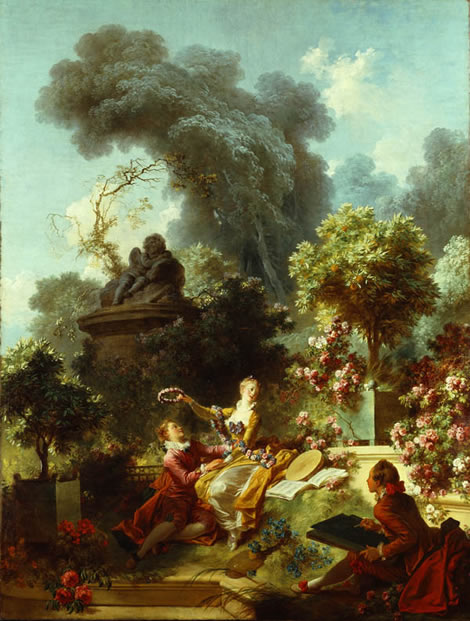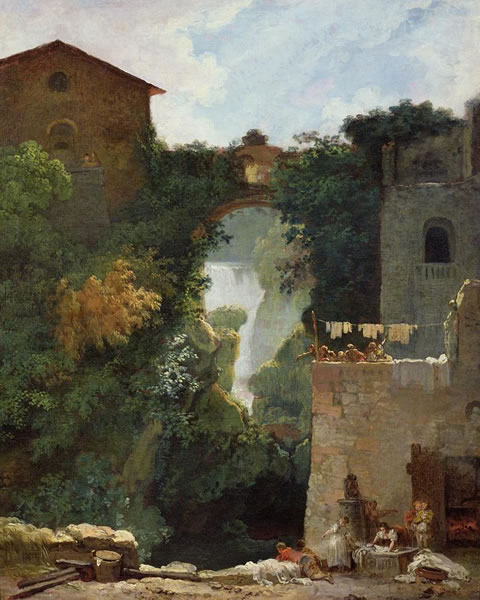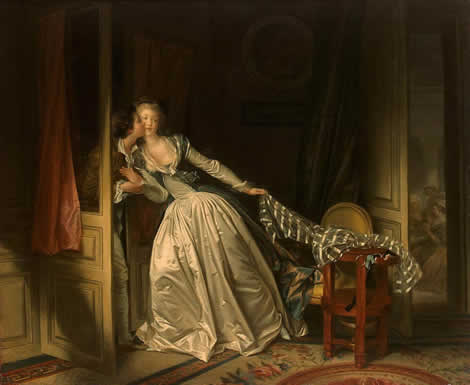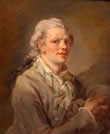Paintings

The Lover Crowned, 1771–73. Oil on Canvas. 243 cm. x 318 cm. Frick Collection, New
York
The Rococo style in painting, established in France early in the century
by Antoine Watteau, was sensuous and accomplished, appealing to the sophisticated
taste of aristocratic patrons. A great deal of skill went into its luminous colors,
complex surfaces, refined textural contrasts, free brushwork, and asymmetrical compositions
based upon the interplay of curved lines and masses. Often depicted was the game of
love treated in a playful manner, and Fragonard indeed took the 'fête galante'
in new directions. Where Watteau was reserved and melancholy, Fragonard was playful,
even frivolous, depicting unreal situations in unreal settings.
No one could
call 'The Lover Crowned' an honest depiction of France at the time, or indeed
any time. Sunlight bathes a garden which luxuriates in roses and other flowers. A
statue stands guardian, or rather sleeps, and over the scene tower masses of trees
as insubstantial as summer clouds. A young woman, elaborately dressed, and decorated
with yet more flowers, is about to crown a young man as the winner of her affections.
A lute and open book of music lies at her side, and another young man is drawing her
portrait. Young man? Neither seem more than boys done up in pantomime costumes, though
undeniably costly ones.
Paintings so close to 'chocolate box styles' are not
easy to appreciate today, and Fragonard certainly did not appeal to the social conscience
of revolutionary France, nor to the new mercantile spirit of the Second Empire. Even
the contemporary Denis Diderot charged the artist with frivolity and asked him to
show 'a little more self-respect.' Yes, we can note Fragonard's legendary facility,
the delicate brushwork, the glowing colors, the silvery tonality of atmosphere, and
the exuberant gaiety of mood, but aren't the accomplishments now as passé as
the fripperies of last season's fashions?
The answer, I think, is that we have
to see paintings, and indeed all works of art, in the context of their own time and
conventions. England was governed through taxes by Parliament, but the aristocracy
of France were kept from mischief by compulsory attendance at court. With money and
position, but no real power, many in the 'ancien régime' passed their time in
lighthearted entertainment, where living was made an art form (as it still is among
the French upper classes). Fragonard was popular in the early 1770s, most importantly
with the Comtesse du Barry, Louis XV's mistress, who commissioned several decorative
pieces for Louveciennes, her château near Paris. The most famous were a set of four
panels entitled 'Storming the Citadel, The Pursuit, The Declaration of Love',
and 'The Lover Crowned'. Unfortunately for Fragonard, but to the benefit of the
Frick Collection, the pieces were rejected and replaced by the work of Joseph-Marie
Vien, who painted in a more neoclassical style.
As did Boucher, Fragonard kept
his colors on the acid side. Every conceivable area of 'The Lover Crowned' is
crowded with detail, but that detail is not cloying because it is organized and made
subservient to the overall theme. The three figures form a triangle, and that triangle
is repeated in the shaded masses of the foliage and statue, and again in the foaming
mass of trees that half frame the light clouds. The young woman's head is accentuated
by a dark background. The same device, in reverse, is used to accentuate the portrait
artist and the statue beyond. These strong diagonals that lead the eye towards the
top left corner of the painting are balanced by equally strong diagonals to the top
right corner. The garden seems a tumbling mass of trees, shrubs, flowers and figures
where the contrasts (try half closing your eyes) make an ever lively balance of shapes.
Fragonard painted quickly, but had an excellent, seeming artless sense of composition.
Most artists plan their compositions carefully, but in Fragonard the gift seems innate,
as though he made up these vibrant shapes and masses as he went along, which indeed
he may have done, though he also called on extensive drawings made during his Italian
journeys.

The
Falls of Tivoli. Oil on Canvas. 61 cm. x 73 cm. Louvre, Paris.
The work is generally
dated to the early 1760s and shows the influence of Tiepolo in its palette, though
not its theme. The piece, which entered the Louvre in 1869, when Fragonard's accomplishments
were being reassessed and recognized, reflects the eighteenth century taste for the
picturesque — a style that even now (though often debased) is still popular with
visitors to Italy. Fragonard's colors are softer and warmer than in the piece above,
and there are pleasing atmospheric effects that give a staged sense of depth. Details
are also more closely harmonized within the composition: the light tan color of the
washing is repeated in the foliage opposite, the stonework and in the capstone to
the bridge. The red in the shirt of the figure staring at the water is only the end
of a series of rich, dusky browns and milky pink-orange colors that contrast with
the bluish greens of the foliage. The little blue seen in the sky is muted, and seems
the continuation of the spray-filled gorge seen through the bridge.
The composition
is based on repeated oblongs and arches — the last in the bridge itself and the
rounded entrances in buildings left and right. A key element is the disposition of
light and shade, with shadowed bridge juxtaposed between sunlight areas in the foreground
and the muted sky and background. No area is one unbroken tone, however. The background
shows the falls higher in tone than the sky. The middle ground shade is broken by
the bridge capstone, the foliage catching the sun on the left and by figures on the
right sitting on or working in front of building with dark interiors. The foreground
has high contrasts in the workmen's tools and laundry left out to dry.

The Stolen Kiss late 1780s. Oil and Canvas. 45 cm x 55 cm. Hermitage Museum,
Saint Petersburg.
Fragonard turned to more serious styles of Neoclassicism in
the 1770s and 1780s, and this piece, though hardly the ennobling scene expected of
Neoclassicism, is restrained and simple in composition, with detail lost into the
interior shadow of the room. The line is cleaner and the palette more restricted:
mainly yellow through to red, all muted, these contrasting with an olive green in
the scarf and an olive tinge to the dress. Both scarf and dress are treated in great
detail, and are what captures the eye — a diagonal thrust of shimmering fabric
between the door uprights, which are buttressed by curtain and half-seen lover on
one side and the glimpse on an interior on the other. The lover's face and the woman's
eyes turn right, directing us to the central darkness of the painting. It's an unsettling
piece whose composition echoes the snatched display of affection (if such it is: critics
disagree).
Fragonard employed the palette of François Boucher, but with
warmer colors, more use of impasto and greater attention to surface effects. Boucher
used a dead-colored base, i.e. under-painting in earth-colors and over-painting with
glazes that included flake white Naples yellow, yellow ochre, vermilion, rose madder,
crimson lake, brown ochre, burnt sienna and cobalt blue.



